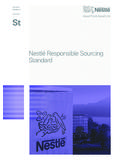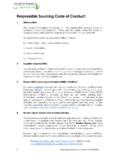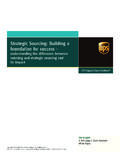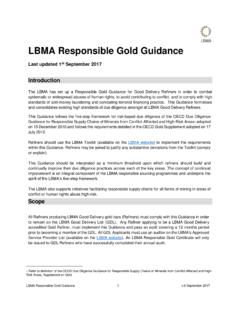Transcription of -:HSTCQE=V]ZUVW: 20 2012 08 1 P - oecd.org
1 -:HSTCQE=V]ZUVW:isbn 978-92-64-18501-2 20 2012 08 1 POECD Due Diligence Guidance for responsible supply Chains of Minerals from Conflict-Affected and High-Risk AreassECOnD EDitiOnContentsRecommendation of the Council on Due Diligence Guidance for responsible Supply Chains of Minerals from Conflict-Affected and High-Risk AreasOECD Due Diligence Guidance for responsible Supply Chains of Minerals from Conflict-Affected and High-Risk Areas Supplement on tin, tantalum and tungstenSupplement on goldOECD Due Diligence Guidance for responsible supply Chains of Minerals from Conflict-Affected and High-Risk AreasOECD Due Diligence Guidance for responsible supply Chains of Minerals from Conflict-Affected and High-Risk AreassECOnD EDitiOnConsult this publication on line at work is published on the OECD iLibrary, which gathers all OECD books, periodicals and statistical for more Due DiligenceGuidance for ResponsibleSupply Chains of Mineralsfrom Conflict-Affectedand High-Risk AreasThis document and any map included herein are without prejudice to the status ofor sovereignty over any territory.
2 To the delimitation of international frontiers andboundaries and to the name of any territory, city or 978-92-64-18501-2 (print)ISBN 978-92-64-18505-0 (PDF)Photo credits:Cover to OECD publications may be found on line edition november 2012 OECD 2013 You can copy, download or print OECD content for your own use, and you can include excerpts from OECD publications, databases and multimedia products in your own documents, presentations, blogs, websites andteaching materials, provided that suitable acknowledgment of OECD as source and copyright owner is requests for public or commercial use and translation rights should be submitted for permission to photocopy portions of this material for public or commercial use shall be addresseddirectly to the Copyright Clearance Center (CCC) the Centre fran ais d exploitation dudroit de copie (CFC)
3 Cite this publication as:OECD (2013),OECD Due Diligence Guidance for responsible Supply Chains of Mineralsfrom Conflict-Affected and High-Risk Areas: Second Edition, OECD DUE DILIGENCE GUIDANCE FOR responsible SUPPLY CHAINS OF MINERALS FROM OECD 20133 ForewordTheOECD Due Diligence Guidance for responsible Supply Chains of Mineralsfrom Conflict-Affected and High-Risk Areas( the Guidance ) is the first exampleof a collaborative government-backed multi-stakeholder initiative on responsiblesupply chain management of minerals from conflict-affected areas. Its objective is tohelp companies respect human rights and avoid contributing to conflict through theirmineral sourcing practices. The Guidance is also intended to cultivate transparentmineral supply chains and sustainable corporate engagement in the mineral sectorwith a view to enabling countries to benefit from their mineral resources andpreventing the extraction and trade of minerals from becoming a source of conflict,human rights abuses, and insecurity.
4 With its Supplements on Tin, Tantalum,Tungsten and Gold, the OECD Guidance provides companies with a complete packageto source minerals responsibly in order for trade in those minerals to support peace anddevelopment and not Guidance was developed through a multi-stakeholder process with in-depthengagement from OECD and eleven countries of the International Conference on theGreat Lakes Region (Angola, Burundi, Central African Republic, Republic of Congo,Democratic Republic of Congo, Kenya, Rwanda, Sudan, Tanzania, Uganda andZambia), industry, civil society, as well as the United Nations Group of Experts on theDRC. Five multi-stakeholder consultations were held to develop the Guidance and itstwo Supplements, with four in Paris in December 2009 and April 2010 as well as Mayand November 2011.
5 A joint ICGLR-OECD consultation was held in Nairobi inSeptember 2010 where Brazil, Malaysia and South Africa were also represented. As aresult, the Guidance is practically-oriented,with emphasis on collaborative constructiveapproaches to complex United Nations Security Council resolution 1952 (2010) [S/RES/1952(2010)]supported taking forward the due diligence recommendations contained in the finalreport of the United Nations Group of Experts on the Democratic Republic of the Congo,designed to be consistent with the OECD Due Diligence Guidance has been approved by the OECD Investment Committee and theOECD Development Assistance Committee, and has been endorsed by the elevenmember states of the International Conference on the Great Lakes Region (ICGLR) inthe Lusaka Declaration, adopted on 15 December 2010.
6 An OECD Recommendation onthe Due Diligence Guidance was adopted by Council at Ministerial level onFOREWORDOECD DUE DILIGENCE GUIDANCE FOR responsible SUPPLY CHAINS OF MINERALS FROM OECD 2013425 May 2011 and subsequently amended on 17 July 2012 to include a reference to theSupplement on Gold. While not legally binding, the Recommendation reflects thecommon position and political commitment of OECD members and OF CONTENTSOECD DUE DILIGENCE GUIDANCE FOR responsible SUPPLY CHAINS OF MINERALS FROM OECD 20135 Table of ContentsRecommendation of the Council on Due Diligence Guidancefor responsible Supply Chains of Minerals from Conflict-Affectedand High-Risk 7 OECD Due Diligence Guidance for responsible Supply Chainsof Minerals from Conflict-Affected and High-Risk 12 What is due diligence in the mineral supply chainand why is it necessary?
7 13 Who should carry out due diligence?.. 15 Structure of the 16 Nature of the 16 Annex Framework for Risk-Based Due Diligencein the Mineral Supply 17 Annex Supply Chain Policy for a responsible GlobalSupply Chain of Minerals from Conflict-Affectedand High-Risk 20 Annex Measures for Risk Mitigation andIndicators for Measuring 25 Supplement on Tin, Tantalum and 31 Scope and 32 Red flags triggering the application of this 33 STEP 1: Establish strong company management 36 STEP 2: Identify and assess risks in the supply 41 STEP 3: Design and implement a strategy to respondto identified 44 STEP 4: Carry out independent third-party auditof smelter/refiner s due diligence 47 STEP 5.
8 Report annually on supply chain due Note for Upstream Company Risk Assessment .. 54 Supplement on 61 Introduction and 65 TABLE OF CONTENTSOECD DUE DILIGENCE GUIDANCE FOR responsible SUPPLY CHAINS OF MINERALS FROM OECD 20136 STEP 1: Establish strong company management 72 STEP 2: Identify and assess risks in the supply 78 STEP 3: Design and implement a strategy to respond to identified risks 99 STEP 4: Carry out independent third-party audit of refiner s duediligence 106 STEP 5: Report annually on supply chain due 111 AppendixSuggested measures to create economic and developmentopportunities for artisanal and small-scale 114 Figure1. Risks in the supply chain of tin, tantalum and tungstenfrom conflict-affected and high-risk 352.
9 Risks in the supply chain of gold from conflict-affected andhigh-risk 71 RECOMMENDATION OF THE COUNCIL ON DUE DILIGENCE GUIDANCE FOR responsible DUE DILIGENCE GUIDANCE FOR responsible SUPPLY CHAINS OF MINERALS FROM OECD 20137 Recommendation of the Council on DueDiligence Guidance for responsible SupplyChains of Minerals from Conflict-Affected andHigh-Risk Areas1As amended on 17 July 2012 THE COUNCIL,Having regard to Article 5(b) of the Convention on the Organisation forEconomic Co-operation and Development of 14 December 1960;Having regard to the Guidelines for Multinational Enterprises which formpart of the Declaration on International Investment and MultinationalEnterprises;Recalling that the common aim of governments recommending theobservance of the Guidelines for Multinational Enterprises and thedevelopment community is to promote principles and standards forresponsible business conduct;Observing that responsible sourcing of minerals has developmental andbusiness dimensions;Having regard to the Policy Framework for Investment adopted in 2006which aims to mobilise private investment in a way which supports steadyeconomic growth and sustainable development.
10 Recalling the work of the Development Assistance Committee in the fieldof international engagement in fragile states, aimed at avoiding harm whenengaging in fragile and conflict-affected environments, including the1. At the time of adoption, Brazil made the following statement: In adhering to thepresent Recommendation Brazil understands that the Due Diligence Guidance hasbeen developed on the basis of the experience in the Great Lakes Region in is of the view that companies should take due account of relevant decisionsby the United Nations, including resolutions of the UN Security Council, indetermining if other zones of operation can be considered to be conflict-affected orhigh-risk areas. Recommendation of the Council on Due DiligenceGuidance for responsible OF THE COUNCIL ON DUE DILIGENCE GUIDANCE FOR responsible DUE DILIGENCE GUIDANCE FOR responsible SUPPLY CHAINS OF MINERALS FROM OECD 20138 Principles for Good International Engagement in Fragile States and Situationsendorsed at its High Level Meeting on 3-4 April 2007;Recalling the efforts of the international community to cooperate in thefight against corruption, including through the OECD Convention onCombating Bribery of Foreign Public Officials in International BusinessTransactions and the United Nations Convention Against Corruption.















